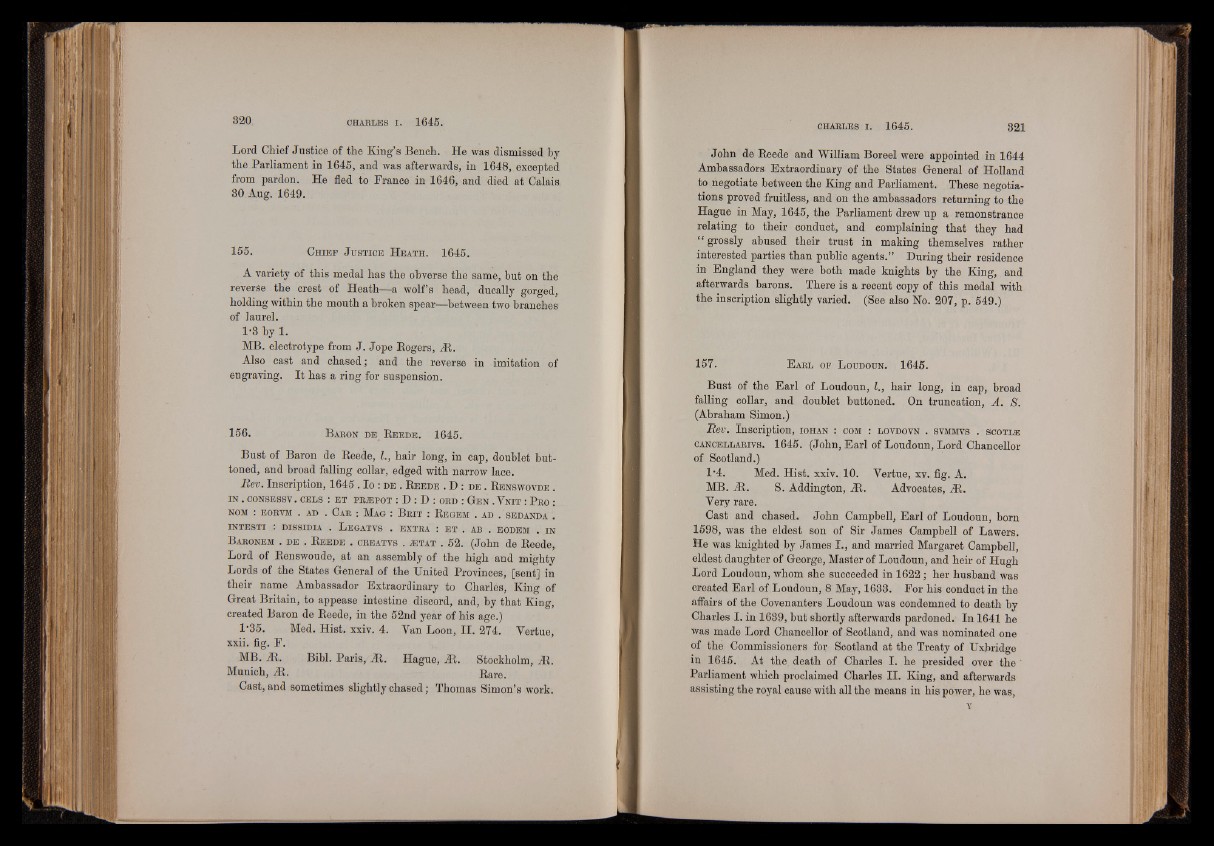
Lord Chief Justice of the King’s Bench. He was dismissed by
the Parliament in 1645, and was afterwards, in 1648, excepted
from pardon. He fled to France in 1646, and died at Calais
30 Aug. 1649.
155. C h i e f J u s t ic e H e a t h . 1645.
A variety of this medal has the obverse the same, but on the
reverse the crest of Heath—a wolf’s head, ducally gorged,
holding within the mouth a broken spear—between two branches
of laurel.
1-8 by 1.
MB. electrotype from J. Jope Bogers, At.
Also cast and chased; and the reverse in imitation of
engraving. It has a ring for suspension.
156. B aron d e R e e d e . 1645.
Bust of Baron de Reede, I., hair long, in cap, doublet buttoned,
and broad falling collar, edged with narrow lace.
Rev. Inscription, 1645 . Io : d e . R e e d e . D : d e . R enswo v d e .
in . c o n s e s sv . c e l s : e t p e je po t : D : D : obd : G e n . V n it : P eo :
nom : eo evm . ad . C a e : M ag : B e i t : R e g em . ad . sedanda .
INTESTI : DISSIDIA . L e GATVS . EXTEA : ET . AB . EODEM . IN
B a eo n em . d e . R e e d e . c beatvs . « tat . 52. (John de Reede,
Lord of Renswoude, at an assembly of the high and mighty
Lords of the States General of the United Provinces, [sent] in
their name Ambassador Extraordinary to Charles, King of
Great Britain, to appease intestine discord, and, by that King,
created Baron de Reede, in the 52nd year of his age.)
1-35. Med. Hist. xxiv. 4. Van Loon, II. 274. Yertue,
xxii. fig. F.
MB. At. Bibl. Paris, At. Hague, At. Stockholm, At.
Munich, At. Rare.
Cast, and sometimes slightly chased; Thomas Simon’s work.
John de Reede and William Boreel were appointed in 1644
Ambassadors Extraordinary of the States General of Holland
to negotiate between the King and Parliament. These negotiations
proved fruitless, and on the ambassadors returning to the
Hague in May, 1645, the Parliament drew up a remonstrance
relating to their conduct, and complaining that they had
“ grossly abused their trust in making themselves rather
interested parties than public agents.” During their residence
in England they were both made knights by the King, and
afterwards barons. There is a recent copy of this medal with
the inscription slightly varied. (See also No. 207, p. 549.)
157. Eabl of Loudoun. 1645.
Bust of the Earl of Loudoun, I., hair long, in cap, broad
falling collar, and doublet buttoned. On truncation, A. S.
(Abraham Simon.)
Rev. Inscription, iohan : com : lovdovn . svmmvs . scotle
cancellabtvs. 1645. (John, Earl of Loudoun, Lord Chancellor
of Scotland.)
1‘4. Med. Hist. xxiv. 10. Vertue, xv. fig. A.
MB. At. S. Addington, At. Advocates, At.
Very rare.
Cast and chased. John Campbell, Earl of Loudoun, born
1598, was the eldest son of Sir James Campbell of Lawers.
He was knighted by James I., and married Margaret Campbell,
eldest daughter of George, Master of Loudoun, and heir of Hugh
Lord Loudoun, whom she succeeded in 1622; her husband was
created Earl of Loudoun, 8 May, 1633. For his conduct in the
affairs of the Covenanters Loudoun was condemned to death by
Charles I. in 1689, but shortly afterwards pardoned. In 1641 he
was made Lord Chancellor of Scotland, and was nominated one
of the Commissioners for Scotland at the Treaty of Uxbridge
in 1645. At the death of Charles I. he presided over th e '
Parliament which proclaimed Charles II. King, and afterwards
assisting the royal cause with all the means in his power, he was,
Y